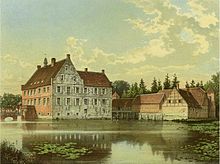Heinrich I. von Droste zu Hülshoff
Heinrich I von Droste zu Hülshoff (* 1500 ; † 1570 ) was a councilor of the city of Münster and landowner of Hülshoff Castle . Most famous is his depiction as a knight who was involved in the reconquest of Münster from the Anabaptists, as an equestrian relief at Hülshoff Castle.
Life
Origin and family
Heinrich I came from the 12th known generation of Droste zu Hülshoff and was the first family member to move his permanent residence in 1530 from the family's town courtyard to Hülshoff Castle, which was acquired in 1417. Nevertheless, he and his wife were still buried in the old family crypt in the Überwasserkirche . He had a brother Johann († 1547) who was a scholaster in the canons of St. Martini (Münster) and a college friend of the Reformation preacher Bernd Rothmann . A sister Adelheid was a cellar lady in the monastery of St. Aegidii (Münster) .
In 1535 Heinrich I married Anna von Steveninck zu Möllenbeck, who was described as a "most lovable lady" and brought a not insignificant fortune into the marriage. With her he had 10 children, including his successor and long-time first mayor of the city of Münster, Bernhard II von Droste zu Hülshoff .
Military service for the Bishop of Munster
With his father, the former mayor Johann VII. Droste zu Hülshoff and his cousins Everwin III. Droste zu Handorf and Alhard III. Droste zu Uhlenbrock (both were sons of the former mayor Everwin II. Von Droste zu Handorf ), Heinrich I, as vassal of Prince-Bishop Franz von Waldeck, had to take part in the siege and liberation of the city of Münster from Anabaptist rule with a brush and five horses . When he saw his parents' house looted by the Anabaptists, the Erbmannshof at Krummen Timpen, tears should have come to him. There was no compensation for these and other family losses; instead of the pay he was entitled to, he only received confiscated Anabaptist property worth 30 guilders (this may have included a painting by an Anabaptist guide, which is still on display in Hülshoff Castle). He had to pay the rest of the war costs himself, even though some of his farms were desolate and unoccupied because of the war events and the family estate at Leuchtenberk had lost its tax exemption. In 1538 and 1540 he had to go to war again with his bishop against the Count of Oldenburg.
City council in Münster
In 1536 Heinrich I was one of the city councilors of Münster, who - after the city council elections were banned - were appointed by the bishop. So he probably had to take part in the cruel (then unfortunately legal) execution of the Anabaptist leaders in front of the Lambertikirche (Münster) and the subsequent measures in the devastated city. In the first free election of the city council in 1554, he was elected, but did not accept the election. The city then sued him with the prince-bishop, unsuccessfully. He could rely on his decree that heirs who did not live in the city could not be forced to accept. Heinrich I was a man who enjoyed general respect, was often consulted by Bishop Franz von Waldeck and used in several missions. He also had good relations with the nobility, especially with the Counts of Münster (Westphalian noble family) and Bentheim-Steinfurt , with whom his family had been related since the Middle Ages.
Landowner and client on Hülshoff

Despite his obligations in Münster, Heinrich I was able to invest a lot in his goods. Above all, he acquired the Schonebeck farm in Roxel , which gave Gut Hülshoff its economic importance. He also bought or exchanged properties in Münster- Überwasser , Greven , Nordwalde , Altenberge , Nienberge and Havixbeck to round things off . In 1545 he had also bought Wilkinghege , but immediately exchanged it again. He was also the heir to the old family estates at Everswinkel . Between 1546 and 1549, he expanded and fortified Hülshoff Castle for 14,000 to 15,000 thalers. He built perimeter walls, a three-story watchtower and a Renaissance - Erker , which were discontinued in the 18th century.
literature
- Wilderich from Droste to Hülshoff : 900 years of Droste to Hülshoff . Verlag LPV Hortense von Gelmini, Horben 2018, ISBN 978-3-936509-16-8
- J. Holsenbürger: The gentlemen v. Eckenbrock (by Droste-Hülshoff) and their possessions. Münster iW 1869.
| personal data | |
|---|---|
| SURNAME | Droste zu Hülshoff, Heinrich I. von |
| BRIEF DESCRIPTION | Councilor of the city of Münster and landowner of Hülshoff Castle |
| DATE OF BIRTH | 1500 |
| DATE OF DEATH | 1570 |

